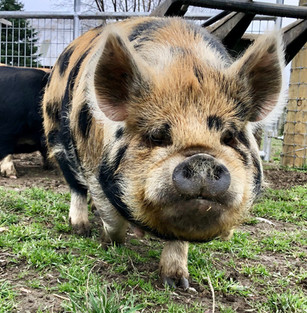Designer Kunekune: A Word Of Caution, Part II
- Barbara Rossi
- Nov 22, 2020
- 5 min read
Updated: Nov 23, 2020
In this series of Blog Posts I am taking a look at Kunekune traits that have been taken to extremes or led to less desirable results in the breed. In my previous blog I wrote about the problems I see occurring when the short snout of a Kunekune is taken to the extreme. In Part II, I will tackle the ears of the Kunekune and how certain types can be more of a detriment.
Trait 2
Ear Shape and Position:
I'm sure many of you are asking how ear shape and position can be a negative to overall health? Let's take a look at what the ear function is all about and then compare three types of Kunekune ears.
What is the purpose of animal ears to begin with? Ears are organs that are divided into internal and external parts. The size and function of the ear is the result of evolutionary adaptation. ('Best of Nature') Ears are shaped and positioned on the head to best suit the needs of the specific animal.
Examples: Elephants have huge ears that have blood vessels close to the surface. This, along with the flapping of the ears helps cool the elephant. Cats have relatively large ears that help them hunt prey. A horse has ears that contain muscles allowing them to move in all directions. This is key to their flight response and survival from natural predators. So what is the purpose of pigs ears?
Pigs have sensitive hearing, better than humans at higher frequencies. Wild pigs have a very keen sense of hearing and this is one reason why they are difficult to find. A sow will definitely know when her piglets squeal and is immediately reactive. Their sense of hearing is important in survival and makes up for their poor eyesight.
Both Kunekune Registries, AKPR and AKKPS have breed standards that accept both upright and flopped ears. My concern is when the flopped becomes exaggerated and hinder or curbs eyesight and possibly hearing. I do not believe any animal is meant to have ears that hinder other senses in any way. Any animal having obstructed eyesight or hearing has less chance of survival.
Here are examples of three types of ears. Two accepted by the standard and the third (folded), in my breed standard, is a fault. As you look at the photos in the upright and semi-lopped I would also like you to look at the eyes and compare. What do you notice?
Upright, Pricked Ears
Semi-Lopped, Inclined Forward
Not only do Semi-Lopped ears partially hinder eyesight by falling forward over the eyes, but the downward pressure of the ears on the forehead, combined with a short, upright extreme nose causes the eyes to recess into the folds created by this combination. Thus, hindering eyesight even more. As stated in my first blog about snouts, the severity of this will increase as the pigs mature. We know already that good eyesight is not a strength of pigs, so I believe we should not breed for a trait that makes it worse.
In addition to decrease in eyesight, ears that are inclined forward over the eyes and not erect can not pick up on sounds as well. Have you ever had to walk out into the field to get the attention your pig because there head was down while eating and they didn't hear you?
"Why does it really matter you might ask? My pigs are still just fine and live happily."
Example: A sows job during farrowing is to secure a safe place for her offspring to be born. She is alert to sounds and protective of her young in case of danger. A docile, laid back gilt might be calm and completely at ease giving birth and having you around. Great! But as she matures and if she has the extreme flopped ears and extreme upturned nose her behavior shifts during farrowing. She suddenly becomes very agitated during farrowing and unsettled with noises or movement. She is up and down during farrowing and swings around quickly with your movement in the stall. Why? Well, take away her ability to see better, hear better, and even breath better and you have dampened three of her very important senses. She is uneasy because she can't make complete sense of her surroundings to feel comfortable and laid back.
Whether farrowing or just during general care such as feeding and giving medical attention you will find a pig that is lacking all or part of his senses might be more jumpy, less attentive, loud, reactive to movement and touch, startled easier etc..
Folded: a Bel Canto Farm breed standard fault
While folded ears might not be in the way of eyesight, it is considered a Breed Standard fault in my book and should not be bred for. Kunekune is not a breed that has folded ears. Most folded ears do not sit forward inclined, in fact they are usually held out to the side of the head. I guess you could argue that the fold might hinder some of their hearing ability as it partially covers the ears opening or that by not facing forward they do not pick up on sound in front as well.
I breed against folded ears. I have noticed that some piglets born with folded ears also seem to have something else awry. Maybe failure to thrive, hunched back or poor conformation or, as in the ginger/bl piglet photo above, she also had an extra growth coming out of one of her ears and she died of seizures at age one. I often see the folded ears as a sign that maybe something isn't quite right but not visibly showing. No science here, just my own observation and feelings about it. Piglets with folded ears are not kept in my breeding program.
My Favorite Ear
I would have to say that my favorite Kunekune ears are those big heart shaped ears that are forward inclined but still upright, allowing nice bright eyes to have clear eyesight. Not hindering the eyes at all, big and open for hearing everything from the farmer calling them in to eat, to a danger that might be around.
To wrap up: Kunekune are a diverse breed of pig. It's healthy for your herd to have diversity and so multiple ear type is acceptable. I have upright ears, semi-lopped and some extreme. As with the extreme nose, we have to be careful and use crossing out as a way to keep those extremes to a happy medium. As breeders we must be aware of how breeding for singular traits might actually hurt your breeding goals in another way. Always keep this in mind and breed for overall health and balance throughout.
Part III of the series will take a look at the Kunekune and breeding for short legs and size. How might this hinder your pig?


























Comments